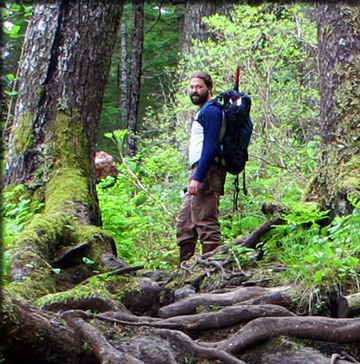Post-Meeting Content
FEMC has made available as much content from the meeting as possible. You can:
- Watch the opening remarks and invited speakers at the plenary session
- Read abstracts, download presentations, and view video from the contributed talks sessions, and
- View the posters presented at our poster session
The proceedings for the conference are now available.
Welcome and Introductory Remarks
A brief update on the Forest Ecosystem Monitoring Cooperative network, structure, services, and future.
Plenary Session
Keynote Presentation
Panel discussion reflecting on this year's conference theme: "Advances in Forest Science: The role of innovation and technology in stewardship and engagement"
Dr. Colin Beier, SUNY-ESF
Contributed Talks
Four parallel tracks of 20-minute presentations contributed by cooperators on various forest ecosystem research, monitoring and outreach activities
Session 1
| Tools and Techniques 1 Moderator: FEMC | Carbon Storage Moderator: FEMC | Restoration Moderator: FEMC | Disturbance Moderator: FEMC |
|
|---|---|---|---|---|
A Tour of the Northeastern Forest Inventory Network (NEFIN) Xana Wolf ABSTRACT VIDEO PRESENTATION | Relative effects of functional diversity and structural complexity on late-successional, northeastern hardwood forest carbon Samantha Myers ABSTRACT VIDEO PRESENTATION | Barriers for emerging tree planting strategies in response to global change Peter Clark ABSTRACT VIDEO PRESENTATION | Regeneration Response to Salvage Logging Following Tornado Disturbance Colby Bosley-Smith ABSTRACT VIDEO PRESENTATION | |
A Tour of the Northeastern Forest Inventory Network (NEFIN) Xana Wolf, FEMC Presenter: Xana Wolf, FEMC There are numerous continuous forest inventories (CFI) that have recorded forest conditions across the Northeastern United States for the past several decades. The Northeast Forest Inventory (NEFIN) project was developed as a collaborative effort led by the FEMC to aggregate and standardize CFI data from various monitoring programs across the region into a consolidated online tool. The goals of this project are to (1) increase the accessibility and usability of forest inventory data from disparate collections in the northeastern US, (2) demonstrate how the research community can utilize this data for investigating trends in and drivers of forest growth and yield over time, and (3) enable greater exchange of information and expand collaborations around analyzing trends in northeastern forests. This talk will provide an overview of the tool developed under the NEFIN project that standardizes data from many different continuous inventory programs and provides ways to search, aggregate and download that data. | ||||
Relative effects of functional diversity and structural complexity on late-successional, northeastern hardwood forest carbon Samantha Myers, University of Massachusetts Amherst Presenter: Samantha Myers, University of Massachusetts Amherst Understanding forest stand conditions that support high levels of carbon storage and sequestration is of critical importance given increasing regional interest in forest carbon management. While numerous carbon management approaches exist, there is limited stand-level guidance to support such management. Instead, traditional measures of species diversity and structural complexity are used as indicators of a forest ecosystem's capacity to store and sequester carbon. Though these traditional measures of diversity are relatively simple to measure, the diversity of species functional traits may provide valuable information on forest productivity and ecosystem resilience over time. To better understand the role of functional diversity on forest carbon dynamics, we paired existing continuous forest inventory (CFI) data from Massachusetts Department of Conservation and Recreation with local functional trait observations (leaf nutrient content, specific leaf area, and wood density) from trees bordering CFI plots within late-successional forests in western Massachusetts. We applied a Bayesian hierarchical model to quantify the relative effects of functional, species, and structural diversity on live aboveground carbon. Our model importantly synthesized local functional trait information with existing species-level mean trait values applying a multivariate structure that accounts for inherent trait syndromes. Across 323 plot-year combinations, we found that structural complexity, functional diversity, and total basal area explained most of the variability in live aboveground carbon (R2= 0.91 [0.90, 0.93]). Replacing functional diversity with species diversity explained slightly less variability (R2=0.89 [0.87, 0.91]). Contrary to expectations, we found that functional diversity had a negative relationship with live aboveground carbon, possibly due to functional redundancy of dominant late-successional species in high-carbon plots. Study results will inform adaptive forest carbon management by synthesizing new understanding of the relative contributions of forest structure and functional diversity to long-term carbon storage in late-successional hardwood forests in the northeastern U.S. | ||||
Barriers for emerging tree planting strategies in response to global change Anthony D'Amato, University of Vermont, Rubenstein School of Environment and Natural Resources Presenter: Peter Clark, University of Vermont, Rubenstein School of Environment and Natural Resources Tree planting is increasingly being pursued as a strategy to mitigate, restore, or adapt forest ecosystems for global change. Although reforestation has long been central to forest management, the novelty and desired outcomes of emerging tree planting strategies are not without barriers linked to institutional capacity (e.g., tree nurseries) and knowledge gaps (e.g., best management practices). In this presentation, we summarize how planting strategies address global change and illustrate how factors primarily associated with seedling availability (e.g., insufficient diversity among species, genotypes/seed origin, stock types) will limit operationalizing these strategies. To overcome these challenges, we recommend avenues for advancement via 1) improved policy and financing, 2) resources and training, and 3) research and monitoring. Absent these advances, current seedling production capacity and practices will fall short of ambitious tree planting goals proposed for restoration, and adapting to, and mitigating the effects of global change. | ||||
Regeneration Response to Salvage Logging Following Tornado Disturbance Colby Bosley-Smith, University of Maine Presenter: Colby Bosley-Smith, University of Maine Understanding the influence of post-disturbance forest management practices on tree regeneration is critical for assessing ecosystem recovery and guiding future responses. Forests often show remarkable resilience to disturbance through recovery of fundamental structures and processes. Evidence suggests that ecosystem processes frequently remain relatively stable despite events prompting clear structural reorganization. While necessary for retrieval of lost timber revenue, post-disturbance management responses such as salvage logging may exacerbate disturbance impacts and disrupt or delay these natural processes. This study seeks to evaluate how salvage logging influences microsite and regeneration outcomes. In July 2013, a rare tornado in northcentral Maine and subsequent salvage logging created an ideal situation in which to evaluate these influences. This series of events generated three clear "treatments": tornado blowdown, blowdown followed by salvage logging, and an undisturbed control. Nine years post-tornado, we inventoried tree regeneration within these treatments (16 plots per treatment) to examine differences in sapling abundance, species composition, and size structure. On these same plots, we also inventoried downed coarse woody debris (CWD), including height of each debris piece above the forest floor. Each sapling was evaluated for evidence of moose browse to determine whether abundant CWD in the blowdown created a 'caging effect,' thereby impeding access and browse by moose. Further, LiDAR data were analyzed to test for differences in canopy openness among treatments. Results revealed greater sapling abundance in the disturbed treatments compared to the control, but no apparent differences in sapling composition or size class. This difference in sapling abundance can be explained by lower canopy openness in the control, as evidenced by LiDAR data. The primary difference between blowdown and salvage was the observed 'caging effect'; that is, the greater volumes and heights of CWD in the blowdown translated to lower proportions of browsed saplings compared to the more structurally simple salvage treatment. Reduced browse in the blowdown may have implications for successional trajectories and future stand development. These results provide greater understanding of ecosystem recovery processes following the successive disturbances of blowdown and salvage logging. | ||||
Urban Tree Inventory Tools and the Road to Healthy Tree Canopy Cover Joanne Garton ABSTRACT VIDEO PRESENTATION | A map-based stock change approach for fine-scale biomass and carbon accounting in New York State Lucas Johnson ABSTRACT VIDEO PRESENTATION | A community led wood ash recycling program to restore forest nutrition in Muskoka, Ontario Shaun Watmough ABSTRACT VIDEO PRESENTATION | Ground Truthing Forest Change in Working Forests of the US Northeast Madeleine Desrochers ABSTRACT VIDEO PRESENTATION | |
Urban Tree Inventory Tools and the Road to Healthy Tree Canopy Cover Joanne Garton, VT UCF Presenter: Joanne Garton, Vermont Urban & Community Forestry Program, VT Department of Forests, Parks and Recreation Updates to the Vermont Municipal Tree Inventory Tool are allowing volunteers, municipal staff, and students of all ages to collect current and precise information about the location, condition, history, and future needs of trees in public ways and public places. Paired with updated public tree policy and legislation, municipalities are using this state-supported tool to feed into urban tree management plans and the budgets they require to grow healthy tree canopy. Joanne Garton, the technical assistance coordinator for the Vermont Urban & Community Forestry Program, tells how three communities are utilizing these urban tree inventory tools, compares these free tools to commercially-available platforms, and explains how small and forested municipalities can still benefit from inventorying and assessing trees along roadsides, on village greens, and anywhere where people walk, drive, live, or play. | ||||
A map-based stock change approach for fine-scale biomass and carbon accounting in New York State Lucas Johnson, State University of New York College of Environmental Science and Forestry Presenter: Lucas Johnson, State University of New York College of Environmental Science and Forestry Field-based forest inventories, like the United States Department of Agriculture's Forest Inventory and Analysis (FIA) program, can provide unbiased stock change estimates of carbon fluxes but are limited by the density and temporal frequency of the sample. However, when field samples are combined with remote-sensing data, a spatially explicit representation of forest inventory information can be produced in the form of a map-based stock change assessment to estimate carbon fluxes at finer spatial and temporal resolutions than possible with field inventory information alone. Time series pixel predictions provide the flexibility to aggregate these individual predictions to units relevant to local forest management, opening the door to the promotion and incentivization of forest-based climate solutions. Landsat time series imagery and the accompanying open-source toolkit, including the Google Earth Engine cloud computing platform and the LandTrendr temporal segmentation algorithm, make this fine-resolution map-based stock change approach feasible. Over 5,000 FIA plots sampled between 2002 and 2019 across New York State were coupled with Landsat spectral indices, disturbance metrics derived from LandTrendr, and topographic and climatic geodata to develop machine learning models for aboveground biomass (AGB) prediction. With these models we generated annual maps (1990-2019), at a 30m resolution, to characterize historical AGB stocks, changes, and spatial patterns across New York State. We then compared our map-derived estimates to a common set of FIA plots, and FIA aggregate estimates across time and across a range of scales. We present this approach and the resulting map products to meet continued demand for time series biomass prediction and mapping, and applications in carbon stock change estimation and ecosystem stewardship. | ||||
A community led wood ash recycling program to restore forest nutrition in Muskoka, Ontario Shelby Conquer, Trent University Presenter: Shaun Watmough, Trent University Almost a century of acidic deposition combined with increasing pressures for forest harvesting have depleted nutrient stocks in soils over large parts of eastern North America. Wood ash has been used for decades in some parts of the world as a mechanism to increase soil fertility, but in Ontario, Canada, wood ash is classified as a waste product and cannot be applied without a permit and so most wood ash is landfilled. Over the past five years a community led wood ash recycling program has been initiated in Muskoka, Ontario. This program actively engages the community in "ash drives" to provide ash for field trials, provides public outreach, and supports ongoing research studies that are needed to identify the benefits and potential harms associated with wood ash additions and to allow wood ash to be reclassified as a fertilizer rather than a waste product. This presentation outlines the challenges and benefits of the program and reports on early results from field trials. | ||||
Ground Truthing Forest Change in Working Forests of the US Northeast Madeleine Desrochers, CAFRI/SUNY ESF Presenter: Madeleine Desrochers, Climate and Applied Forest Research Institute, SUNY Environmental Science and Forestry Remote monitoring tools are a powerful way to track changes to forests at a landscape scale, and the interest and need for these tools are increasing rapidly. A growing number of policies and regulations aimed at addressing climate change are putting more pressure on forest landowners to conserve their land and increase the storage of carbon in their forests. Forest carbon markets, along with other long-standing sustainable forestry certification programs require extensive monitoring and verification. Additionally, as consequence to our changing climate, forest disturbance regimes are expected to shift - with more severe weather events and escalating invasive insect outbreaks. Remote monitoring tools can be used to address these challenges and to provide actionable information on how and where disturbance is taking place - both to understand its effects on forest ecosystem structure, functions, and services and to inform stewardship actions in response. However, while there are many disturbance detection algorithms available, they are largely untested for the disturbance regimes, forest types, and management practices of the northern forest region. Our recent study validated the outputs of three common satellite-based disturbance detection algorithms using detailed harvest records from 43,000 ha of working forest land in northeastern New York. The tested algorithms performed best in detecting clearcuts, but performed much worse and poorly overall in detecting the partial harvest prescriptions (e.g., shelterwoods, thinnings) that are far more common in the northern forest region. Of the three algorithms tested, the Landtrendr algorithm consistently outperformed the others at detecting partial harvests and estimating harvest intensity, but there is still substantial room for improvement. Overall, we suggest that disturbance detection algorithms need further training and tuning to be used for accurate monitoring of harvest-related activities in working forests of the US Northeast. | ||||
Session 2
| Community Science and Monitoring Moderator: FEMC | Climate Change Moderator: FEMC | Tools and Techniques 2 Moderator: FEMC |
||
|---|---|---|---|---|
Vermont's long-term rare plant monitoring in a changing world Aaron Marcus ABSTRACT VIDEO PRESENTATION | Mapping Climate Change Exposure for Northeastern Tree Species Lukas Kopacki ABSTRACT VIDEO PRESENTATION | Virtual Environments for Communicating Changing Forests Michael Mahoney ABSTRACT VIDEO PRESENTATION | ||
Vermont's long-term rare plant monitoring in a changing world Aaron Marcus, VT Fish & Wildlife Presenter: Aaron Marcus, VT Department of Fish & Wildlife Vermont Department of Fish & Wildlife has been monitoring rare plants across the state for decades, with over 40 years of detailed monitoring data on the condition of thousands of plant populations. Now with the increase in community science and increasing capabilities of the Natural Heritage Inventory Database, trends in our plant populations are coming into sharper focus. One trend is an increase in the number of historical (undocumented for more than 25 years) vascular plant taxa being redocumented in recent years. The most well-known example of this is the small whorled pogonia (Isotria medeoloides), first reported by community scientists on iNaturalist, after being unreported for 120 years. An explosion of community science and a more expansive monitoring database have provided a framework for documenting overlooked plant populations that are persisting. Despite this, the Vermont Department of Fish & Wildlife is also simultaneously detecting a number of apparent decline trends for vascular plant species, with a particular concentrations in declines among the orchid family (Orchidaceae). Continued collaboration and analysis is needed to help the Vermont Fish & Wildlife and researchers focus limited resources toward priority management, adaptation, and further research. | ||||
Mapping Climate Change Exposure for Northeastern Tree Species Lukas Kopacki, ArborVox, FEMC Presenter: Lukas Kopacki, Forest Ecosystem Monitoring Cooperative, ArborVox The uncertainty around the impacts of changing climate poses a significant challenge to sustaining forest ecosystems in the northeast. Important work has been done downscaling projected changes in climate conditions, modeling shifts in suitable habitat, and mapping disturbance patterns across the region. The goal of this project is to aggregate these valuable but disparate spatial data sets to quantify relative exposure to climate change impacts at the species, and community level. The resulting climate exposure maps provide insight to how the degree of potential risk exposure vary across the landscape an across species. Results indicate that at the stand level, highest overall exposure to climate, disturbance, and limitations in suitable habitat for current species distributions occurs in mountainous regions throughout the region and southeastern Maine. Across the region relative exposure increases by 4 percent between low and high emission scenarios. Much of our current management is guided by the outcomes of decades of silviculture research, yet many of the conditions under which those results were generated are rapidly changing. These relative exposure maps can inform where climate adaptation management applications may be most necessary over time. | ||||
Virtual Environments for Communicating Changing Forests Colin Beier, SUNY College of Environmental Science and Forestry Presenter: Michael Mahoney, SUNY College of Environmental Science and Forestry Forests are dynamic systems, constantly developing as competition and mortality reshape stand composition and structure over time. However, these changes often happen too slowly for most stakeholders to notice, making it challenging to communicate the long-term impacts of disturbances and management. Visualizations and stakeholder outreach can help to close this gap, but currently most methods for depicting the long-term trajectory of a stand are tailored for expert use and are hard to adapt for a generalist audience. This talk describes a new approach for communicating forest change over time to stakeholders, using interactive three-dimensional (3D) and virtual reality (VR) landscape visualizations to depict forests before, during, and following key landscape changes. By providing a concrete visual explanation for what it means for a forest to change, these virtual environments can be powerful tools for communicating the impacts of forest management and natural disturbances over time to a wide variety of stakeholders. As a case study, we demonstrate how these tools can be used to visualize the impacts of beech bark disease on a stand in the central Adirondacks. We also briefly describe how improvements in technology, including the new "terrainr" and "unifir" R packages, are making the production of virtual environments easier and more reproducible. | ||||
Leveraging Community Science to Complement Professional Field Surveys and Fill Data Gaps for Invasive Insects Mitchell O'Neill ABSTRACT VIDEO PRESENTATION | Decadal Changes in Forest Adabtability and Vulnerabilty to Climate, Inesects, and Disease Soren Donisvitch ABSTRACT VIDEO PRESENTATION | Utilizing occupancy models to compare effectiveness of dogs and humans at detecting the invasive spotted lanternfly in vineyards and forests Angela Fuller ABSTRACT VIDEO PRESENTATION | ||
Leveraging Community Science to Complement Professional Field Surveys and Fill Data Gaps for Invasive Insects Mitchell O'Neill, New York Natural Heritage Program Presenter: Mitchell O'Neill, New York Natural Heritage Program Invasive insects like spotted lanternfly (Lycorma delicatula) can cause major economic and environmental impacts, and monitoring the spread of these species on a broad scale requires extensive effort from many individuals and organizations. While professional surveys are integral to monitoring efforts, there are always temporal and spatial gaps. Data from community science platforms like iNaturalist are often used to supplement species distribution datasets. The value of community science to monitoring efforts increases further when we actively engage community scientists and direct them to conduct surveys of the greatest importance to natural resource managers. For example, we can direct volunteers to survey the locations, species, and ecosystems where information is most needed, or where help from volunteers is most needed to fill gaps between professional surveys. In order to direct community scientists to areas where volunteer spotted lanternfly surveys are most needed to complement professional survey efforts, the New York Natural Heritage Program created an online volunteer sign-up map in collaboration with the NYS Department of Agriculture and Markets and the Partnerships for Regional Invasive Species Management. The interactive online map highlights 1km grid squares available for sign-up across New York State, with each block exhibiting high potential for spotted lanternfly introduction, public land access, or known tree-of-heaven infestations. Participants are trained to identify spotted lanternfly and tree-of-heaven (a preferred host plant) and enter presence and absence survey results into iMapInvasives. This concept of community scientists claiming locations to report observations to iMapInvasives has been applied to monitoring programs for forest pests including Beech Leaf Disease and Hemlock Woolly Adelgid, and could be applied to other large-scale volunteer survey efforts for invasive species. | ||||
Decadal Changes in Forest Adabtability and Vulnerabilty to Climate, Inesects, and Disease Soren Donsivitch, University of Vermont Presenter: Soren Donisvitch, University of Vermont - Master Student United States forests east of the Mississippi are observed to be becoming more vulnerable to climate, insects, and disease, coupled with a general reduction in adaptability. The decadal changes in forest adaptability and vulnerability may be an indicator of increased stress on forest ecosystems. Utilizing USDA Forest Inventory and Analysis data coupled with national trait-driven scoring systems, this study seeks to capture the changes in forest functional trait space and evaluate functional drivers of the observed regional changes. Although a semi-national study, this presentation will focus on changes observed in the Northeastern United States. The Northeast, as a region, is undergoing regionally similar shifts in vulnerability and adaptability scores as well as in captured functional trait space. | ||||
Utilizing occupancy models to compare effectiveness of dogs and humans at detecting the invasive spotted lanternfly in vineyards and forests Angela Fuller, U.S. Geological Survey, New York Cooperative Fish and Wildlife Research Unit, Department of Natural Resources and the Environment, Cornell University Presenter: Angela Fuller, U.S. Geological Survey, New York Cooperative Fish and Wildlife Research Unit, Department of Natural Resources and the Environment, Cornell University Invasive species have the potential to decrease productivity of crop systems, forests, fisheries, and waterways resulting in negative ecological, economic, and societal impacts in the US and worldwide. Prevention and early detection of invasive species are championed as the most cost-effective and efficient strategies for reducing or avoiding these negative impacts on systems. Spotted lanternfly (SLF), Lycorma delicatula, is a recently introduced invasive insect that has been expanding rapidly and causing severe impacts to agricultural production, particularly grapes, since it was first discovered in Pennsylvania in 2014. Human visual surveys are the most common search method employed but can be ineffective due to the insect's cryptic egg masses and low density during early stages of infestation. Therefore, finding alternative SLF early detection methods has become a priority for agencies tasked with addressing SLF management and use of detection dogs has been increasingly considered for this purpose. This study served to test experimentally whether utilizing detector dogs could improve the likelihood of detecting SLF in both agricultural and natural settings. We surveyed transects in 20 vineyards in PA and NJ and used a multi-scale occupancy model to estimate detection probability of human observers and trained detection dogs as a function of SLF infestation level and weather covariates. We hypothesized that 1) occupancy rates vary across sites as a function of the overall SLF infestation level at a site and 2) human and dog detection probability is higher at sites with higher infestation levels because there should be more SLF eggs available for detection. We modeled transect-level occupancy of SLF as a function of infestation level, habitat, topographic position index, and distance to forest. We found that occupancy probability of SLF was higher on vines within the vineyards compared with in the forest and was higher at high infestation sites compared to low infestation sites. Occupancy probability declined with increasing distance from forest which is informative for future search efforts. Detection probability of SLF was lower in forested sites and was higher at high infestation sites. Detection dogs had a lower detection probability than humans in the vineyard, but a higher detection probability than humans in forested sites. The higher detection probability of detection dogs in forested sites was offset by longer dog search time compared with humans. Our study suggests that detection dogs could be more effective than human visual searches as an early detection method for SLF in natural areas and utilizing detector dogs could strengthen SLF early detection efforts. | ||||
Population Dynamics of Montane Invertebrates and Birds Jason Hill ABSTRACT VIDEO PRESENTATION | Patterns and drivers of woodland understory flower phenology and canopy closure Jordon Tourville ABSTRACT VIDEO PRESENTATION | Forest Monitoring for Early Successional Species in the Green Mountains Laurence A. Clarfeld ABSTRACT VIDEO PRESENTATION | ||
Population Dynamics of Montane Invertebrates and Birds Jason Hill, Vermont Center for Ecostudies Presenter: Jason Hill, Vermont Center for Ecostudies Invertebrates perform essential, irreplaceable ecological functions and services, but invertebrate populations are likely experiencing precipitous declines worldwide and shifting to higher elevations and latitudes in response to climate change. These changes may be most pronounced in forested montane environments, where temperatures are warming at a rate of 2-5x the global background rate. This reshuffling of the invertebrate community will ultimately result in pronounced changes to metrics of forest health by altering existing stressors on trees (e.g., herbivory and disease transmission) and influencing avian communities that rely on these invertebrates for food during their breeding season. In June of 2022, we launched an effort to understand how the abundance of montane bird species relates to the local abundance and diversity of invertebrates. We conducted sampling for invertebrates using pitfall and window traps at four dozen montane locations across Vermont and New Hampshire, and collected nearly 5000 invertebrates, which we identified to taxonomic order. In addition, community scientists simultaneously conducted point counts at these same locations to record the abundance of 10 montane bird species through the Mountain Birdwatch program. We'll share insight from the field season about the challenges of conducting invertebrate sampling at remote locations, and examine the relationships between local bird and invertebrate populations. | ||||
Patterns and drivers of woodland understory flower phenology and canopy closure Jordon Tourville, AMC Presenter: Jordon Tourville, Appalachian Mountain Club Warming and changes in precipitation associated with climate change will likely impact the onset of spring flowering and other phenological stages for forest plants across the northeastern United States. Understory forbs of northern hardwood and montane spruce-fir forests may be sensitive to spring warming before canopy closure, however, detailed information on the spatial patterns and drivers of phenological change for these taxa is still lacking. Here, we discuss the results of a preliminary effort to summarize spring leaf out and first flower onset for several canopy tree, understory forb, and spring ephemeral species across elevational gradients in New England. We also compare woodland and alpine plant phenological sensitivity to regional warming. Phenological observations from the Appalachian Mountain Club’s (AMC) Mountain Watch (MW) project, the National Phenology Network (NPN), and iNaturalist were collated and synthesized between 2004 and present (~800,000 observations). Phenological observations were paired with environmental variables and separated by year to uncover (1) spatial patterns of spring understory phenology (and how it relates to canopy closure timing), (2) critical climatic drivers of spring phenology, and (3) phenological responses of understory plants to warmer years. Median flowering time for each year of observation for 14 understory forb species and 10 alpine species, and median leaf out time for 4 canopy tree species were also calculated. Overall, we find strong negative relationships between elevation, spring mean temperatures, accumulated growing degree days (AGDD), and open flower timing for our understory forb species. Additionally, understory flowering times have been shifting earlier than canopy leaf out times, and alpine plant flowering does not appear to be as responsive to warming as lower elevation woodland plants. Our preliminary analyses provide much needed baseline information on woodland phenology across the region. Moving forward, these data will allow us to explore temporal trends in flower and leaf out timing in relation to patterns of warming and help us to better anticipate threats to understory plants. | ||||
Forest Monitoring for Early Successional Species in the Green Mountains Laurence Clarfeld, Vermont Cooperative Fish and Wildlife Research Unit Presenter: Laurence A. Clarfeld, Vermont Cooperative Fish and Wildlife Research Unit Near the turn of the century, most of Vermont's forests had been cleared for logging and pasturing. The past hundred and twenty years has seen a remarkable recovery with > 60% increase in forest cover throughout the state. This has been a great success story for the state's forest-dwelling wildlife species. However, as forests have matured, species that required early successional habitat (ESH) have declined. In spring 2022, the Vermont Cooperative Fish & Wildlife Research Unit, Vermont Fish and Wildlife Department, and Green Mountain National Forest, with financial support from Forest Ecosystem Monitoring Cooperative and Ruffed Grouse Society, began acoustic monitoring of nearly 50 sites in the Green Mountain National Forest. Some sites were near recent cuts while others were at control sites in mature forests. The AMMonitor data management and analysis ecosystem is being used to organize, process, and interpret monitoring data and infer the effect of timber harvest on target species that favor ESH, such as Ruffed Grouse, Eastern Towhee, Blue- and Golden-winged Warblers, Mourning Warbler, and others. A more concerted monitoring effort is needed to assess the role of a diversified forest structure on these high priority species. In this talk, we'll provide an overview of this new research endeavor and an update on preliminary findings. | ||||
Working Groups
Thanks to the many cooperators that took the time to connect and expand collaborative networks and ideas. Summaries of the outcomes of these sessions will be published in the 2022 Conference Proceedings in early 2023
Alpine ecosystems are islands across the northeastern region and are isolated due to their geography. They are also very important places to study and steward, as they contain species sensitive to the impacts of climate change and are unique ecosystems in the region. Joshua Beneš, with the University of Vermont, will give an overview of some historic and recent initiatives to develop regional alpine monitoring and research networks in the northeast and how these networks could integrate into international programs. Nat Scrimshaw, with the World Trails Network Hub for the Americas, will share plans for developing a regional alpine stewardship center. We will conclude by seeking feedback from participants, both online and in-person, about how to design inclusive, effective, and sustainable mountain science and stewardship networks in the region.
Organizer: Joshua Benes, University of Vermont
Phenology is critical to ecosystem processes, from carbon cycling to pollination, and monitoring phenological events can be key to understanding ecosystem response to climate change. In this session we'll share examples of phenology monitoring for natural resource management already happening in the region and identify potential gaps. Together we will explore the benefits of monitoring phenology on a state- and region-wide scale, and outline the potential challenges to embarking on a coordinated phenology monitoring effort. We aim to share lessons learned and develop the groundwork for FEMC partners to make informed decisions about the relative priority of phenology monitoring in forest management. <br /><br /> This will be run as a hybrid session. Alyssa will act as a virtual "moderator" and Alana will be an in-person "moderator".
Organizer: Alyssa Rosemartin [1] and Alana Russell [2], USA National Phenology Network [1], University of Rhode Island [2]
With over 80% of land in Vermont in private ownership, maintaining forest health and resilience relies heavily on the decisions and actions of landowners. Cold Hollow to Canada (CHC) has addressed this challenge by creating a program that convenes neighboring landowners in high priority forest blocks who together learn strategies for maintaining forest resilience, receive technical assistance, and when possible are connected with funding opportunities to put plans into action.
News of the program's success has spread throughout Vermont and even out of state, and Cold Hollow to Canada has been asked by numerous groups for detailed information on how to initiate similar programs, methods for running them, and guidance on how to make similar initiatives successful elsewhere. Thanks to funding from the High Meadows Fund and a Vermont Watershed Grant, CHC has developed an online "Woodlots Toolkit" to enable adoption by conservation groups in other geographies.
In this session, we will share the Toolkit and provide tips on how it can best be used. We will then shift to an engaged discussion about how groups can use or adapt this tool to advance forest stewardship and conservation in locations with different social and physical settings. We recommend attendance by those who work with private landowners with goals of forest stewardship and conservation.
Note: This session will be in-person only.
Organizer: Monica Przyperhart, Program Director, Cold Hollow to Canada
Back to Top
Some presenters have made their posters available for download.
Not Available
Adaptive Silviculture for Wildlife: Supporting forest biodiversity through forest climate adaptation
Jahiya Clark, University of Massachusetts
Toni Lyn Morelli, USGS, University of Massachusetts
Alexej Siren, USGS, University of Vermont
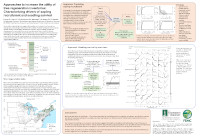
Approaches to increase the utility of tree regeneration inventories: Characterizing drivers of sapling recruitment and seedling survival
Christopher Woodall, USDA Forest Service Research and Development, Forest Inventory and Analysis
Anthony D'Amato, University of Vermont
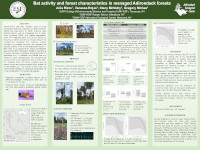
Bat activity and forest characteristics in managed Adirondack forests
Julia Rizzo, SUNY-ESF
Vanessa Rojas, SUNY-ESF Ranger School
Stacy McNulty, SUNY-ESF Adirondack Ecological Center
Gregory McGee, SUNY-ESF Syracuse
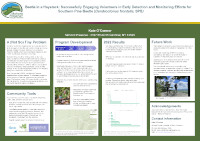
Beetle in a haystack: successfully engaging volunteers in early detection and monitoring efforts for southern pine beetle (Dendroctonus frontalis) at Mohonk Preserve
Kate O'Connor, Mohonk Preserve
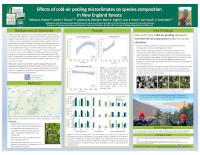
Effects of cold-air pooling microclimates on species composition in New England forests
Aimee T. Classen, University of Michigan Biological Station, Pellston, MI 49769 USA
Anthony W. D'Amato, Rubenstein School of Environment and Natural Resources, University of Vermont, Burlington, VT 05405 USA
Marie E. English, Rubenstein School of Environment and Natural Resources, University of Vermont, Burlington, VT 05405 USA
Jane R. Foster, Rubenstein School of Environment and Natural Resources, University of Vermont, Burlington, VT 05405 USA
Karin Rand, Rubenstein School of Environment and Natural Resources, University of Vermont, Burlington, VT 05405 USA
E. Carol Adair, Rubenstein School of Environment and Natural Resources, University of Vermont, Burlington, VT 05405 USA; Gund Institute for Environment, University of Vermont, Burlington, VT 05401
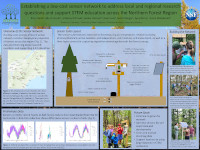
Establishing a low-cost sensor network to address local and regional research questions and support STEM education across the Northern Forest Region
Alix Contosta, UNH Research Associate
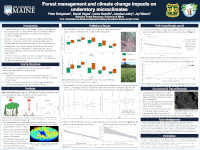
Forest management and climate change impacts on understory microclimates
Daniel Hayes, School of Forest Resources, University of Maine
Laura Kenefic, U.S. Forest Service Northern Research Station, Penobscot Experimental Forest
Jessica Leahy, School of Forest Resources, University of Maine
Jay Wason, School of Forest Resources, University of Maine
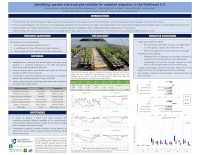
Identifying species and ecotypes suitable for assisted migration in the Northeast U.S.
Matthew Vadeboncoeur, UNH
Heidi Asbjornsen, UNH
Cameron McIntire, USFS
Jay Wason, UMaine
Anthony D'Amato, UVM
Jackson Ehmett, UNH
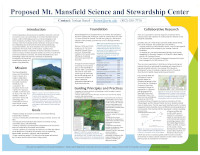
Mount Mansfield Science and Stewardship Center
Joshua Benes, University of Vermont
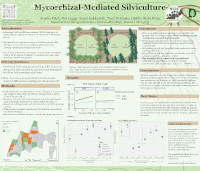
Mycorrhizal-Mediated Silviculture
Amelia Fitch, Eva Legge, Sarah Goldsmith, Tony D’Amato, Caitlin Hicks Pries
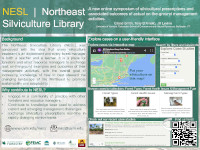
Northeast Silviculture Library
Tony D'Amato, University of Vermont
Jill Levine, University of Vermont
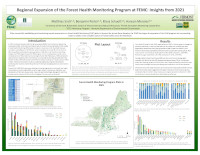
Regional Expansion of the Forest Health Monitoring Program at FEMC: Insights from 2021
Matthias Sirch, Benjamin Porter, Elissa Schuett, Hanson Menzies
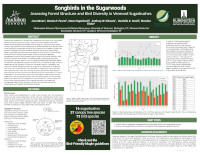
Songbirds in the Sugarwoods: Assessing the Impact of Forest Structure and Diversity on Bird Communities in Vermont Sugarbushes
Liza Morse, University of Vermont: Rubenstein School of Environment and Natural Resources
Steve Faccio, Vermont Center for Ecostudies
Steve Hagenbuch, Audubon Vermont

Twenty years into a 150-year soil monitoring study, significant results!
Donald Ross, UVM
Thomas Villars, NRCS-retired
Angelica Quintana, USDA Forest Service
Jenny Bower, UVM
Joshua Halman, Vermont Dept. of Forests, Parks and Recreation
James Shanley, US Geological Survey
Benjamin Porter, FEMC

